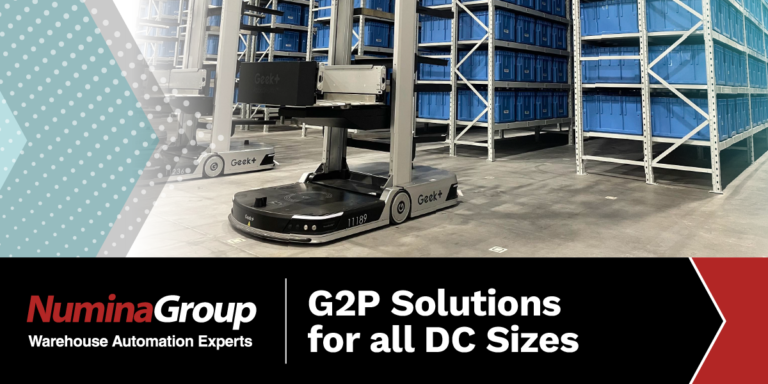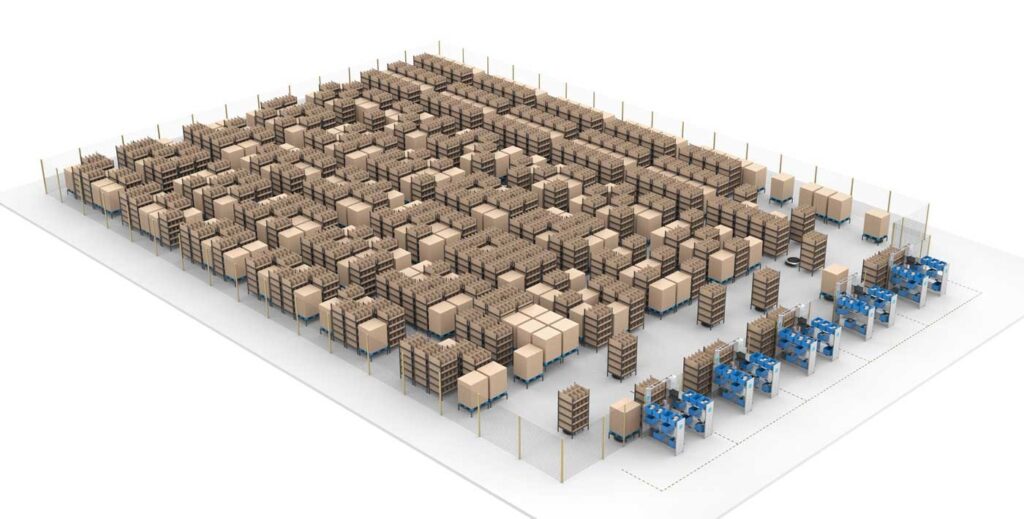
A decade after Amazon created headlines when it purchased Kiva Robotics, autonomous mobile robots and goods-to-person (G2P) solutions are being widely implemented due to their ability to help companies manage their labor shortage challenges.
The latest G2P solutions store and retrieve products or SKUs more efficiently in high-speed picking applications. Buyers can now choose from a range of robotics-based G2P solutions that combine warehouse automation software with a range of autonomous mobile robots (AMRs) from firms such as Geek+, Addverb, Grey Orange, and many other vendors worldwide.
Functionality of robotic-based G2P systems is rapidly expanding, making warehouse robots a more cost-effective automation investment. As a result, G2P and AMRs are the fastest growing product segment in the material handling automation space, with AMRs for the first time outselling automated guided vehicles (AGVs) in 2021.
Robotic-based G2P storage and picking systems are now providing compelling ROIs and being widely deployed by small, medium, and large businesses with B2B, e-com, and omnichannel order fulfillment operations.
Learn more Numina Group’s G2P Solutions
For example, a company with 3,500 SKUs shipping 3,000 to 4,000 orders daily, implementing a small scale robotic G2P solution will reduce order fulfillment picking and replenishment labor costs while generating a rapid return on investment.
The Key to Success? Design First, then Compare and Select the Technology

Successful warehouse automation initiatives should begin with an engineering design study to determine and create a roadmap to implement the right blend of process improvements, automation technologies, and software requirements required to accomplish the project goals.
During the design study, data analysis will determine which types of warehouse automation such as G2P systems, automated conveyor picking systems, pick-to-light, pick-by-voice, or AMR-based batch cart order picking systems best fit the operations requirements.
If the design study recommendations indicate a G2P solution will provide a compelling ROI, the next step is to perform unbiased due diligence to compare and contrast the performance of various G2P systems.
This process should be performed by an independent warehouse automation systems integrator that evaluates technologies and recommends the right blend of technologies that will provide a solution with the most significant efficiency gain.
An engineering design study will compare and define the proper blend of pick, pack, and ship automation and calculate the ROI of a goods-to-person investment. For example, a warehouse with 300 to 400 high-velocity SKUs may be better served by a system that stores and picks the highest velocity items from carton flow or pallet positions along a conveyor line.
If there are thousands of additional skus moving at medium and slow velocity blending a high-speed pick line and a G2P system can better optimize performance efficiency of the automated picking and storage system.
During the design process, another essential factor to consider is the rising cost of warehouse real estate. Factoring in how to best optimize the facility’s building height with technologies that can efficiently store and pick products from the floor to the ceiling will drive a higher return on investment.
Today’s warehouse storage automation technologies increasingly use denser and higher storage technologies to extend the life of existing facilities and reduce the required building footprint for new distribution centers.
Gone are the days when warehouse operations could remain competitive by relying on a manual paper-based order fulfillment operation. Paper-directed pick, pack, and ship processes are very labor intensive and require more supervisor/management positions.
The picking rate for individual workers in manual paper-based picking operations averages 60 to 90 picks per hour, with low primary picking accuracy rates due to human error, resulting in additional labor hours for QC and secondary checking.
The de facto standard rate obtainable from the latest generation robotic G2P picking systems is between 250 to 350 items per person-hour at a pick station, with picking accuracy of 99.9% or better. This speed and accuracy are critical in a same-day order fulfillment operations to keep up with e-commerce and B2B customer expectations.
AI robotic software advancements are helping to drive significant performance gains. This is accomplished by AI continuously looking at SKU velocity movement to optimize and automate the product storage slotting locations, reduce the robots’ travel, and present an optimized batch of orders to the picking stations to achieve worker pick rates of 250 to 350+ lines per hour.
The entire warehouse pick, pack, and ship system performs at the highest level when orchestrated by a top-tier Warehouse Execution and Control System, WCS-WES software platform. This software, such as Numina Group’s Real-Time Distribution Software, RDS, manages and optimizes order release for G2P and the other warehouse automation technologies that increase productivity, lower manual labor dependency, and generate a rapid return on investment.
Ready to learn more? Contact the Numina Group today.
Numina Group provides end-to-end, expert warehouse design, engineering, goods to person and AMR selection and system implementation services.
Talk to one of our warehouse automation experts to learn how Numina works with customers in a collaborative manner to define process improvements and select the right blend of automation to drive the highest productivity at your operation.
We’re excited to invite you to join us at Modex 2022 Booth #B1813 to discover how we blend pick, pack, and ship automation that together drives the greatest gains in DC profitability.

The Numina Group
10331 Werch Drive
Woodridge, IL 60517
630-343-2600
How the Right Warehouse Automation Decisions Can Solve Your Labor Woes As the economy roars